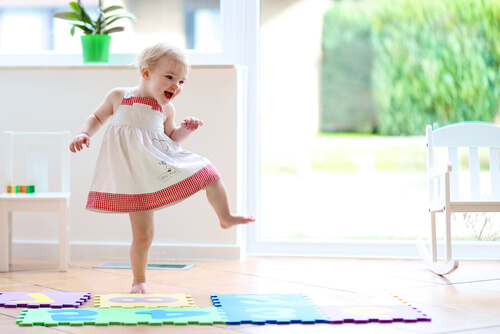Ages 1-2: The Beginning of the Toddler Years
Feb 14, 2022 This was probably one of my favorite time periods in my young children’s lives, so far. Their vocabulary, personality, and growth are astounding during this year. No sooner do they start walking, but they start running!
Toddler development includes that cute babbling and cooing that we loved during the baby months, turn into real words and actual attempts at communication during toddler years. If you don’t believe me, check out this amazing statistic:
“. . . from 18 to 24 months . . . the largest growth within the phonological system takes place . . . also . . . the child’s expressive vocabulary has at least tripled”
(Bauman-Waengler, 2000, p. 107)
The vocabulary triples! Typically, by the time your child turns two, they should be speaking words and even starting to combine them into small sentences! Please check out our other blogs about typical speech development for more information about what is normal and what might be signs of a speech and language delay.

Sounds
When babies are first born, they communicate solely through crying. Language development begins when you notice those cute coos and then the emergence of single sounds. By the time a child reaches two years of age, they should have the following sounds:
- /m/
- /n/
- /h/
- /p/
- /g/
- /d/
- /t/
- /s/
This does not mean that the sounds will always be used correctly or produced accurately. Some of these sounds are not mastered until age 3-4. However, your child should be able to attempt to produce the sounds. In addition, they will add vowels such as “go”, “up,” and “no.”
Once the vowels are added to the consonants, then your child will start creating short sentences like, “daddy up.” Don’t stress the grammar might not be perfect, at first! That comes later in development.
At this point, you might only be able to understand 26-50% of what your child is saying. This percentage will decrease among unfamiliar listeners, such as a stranger at a grocery store. By the time your toddler hits age 2, that accuracy will increase significantly and will continue to rise as your child ages.
Your child will continue putting objects in their mouths. This is because the set of deciduous teeth start to emerge. These can be more painful than the front teeth because they are larger. It’s important to watch for any choking hazards and give your child teething objects to lessen their pain and discomfort.
Finally, don’t be alarmed if your child starts making up funny words that don’t make sense to anyone but them! This is normal development and is called “protowords.” It’s their way of playing with speech sounds and getting used to forming correct words! This will begin to subside around 2-3 years of age.
Boost Your Child’s Speech Development!
Improve language & communication skills with fun learning!

Motor Development
Another fun aspect to watch at this stage of growth is a child’s ability to move and complete motor tasks. At this stage of their lives, children skill development should include the completion of the following tasks:
- 0-11 months = takes first steps
- 1 year and 1 month = uses common objects appropriately
- 1 year and 2 months = picks up small objects with thumb/finger
- 1 year and 3 months = builds tower of 3-4 blocks
- 1 year and 4 months = scribbles lines on paper
- 1 year and 5 months = walk and run unassisted
- 1 year and 6 months = walks up stairs
- 1 year and 7 months = catches ball crudely
- 1 year and 8 months = scribbles in circles
- 1 year and 9 months = jump lifting both feet off the floor
- 1 year and 10 months = climb, squat, kick a ball
- 1 year and 11 months = put shoes on part way
- 2 years old = turn book pages 2 or 3 at a time (McLaughlin, 1998)
Your scheduled pediatrician appointments will confirm if your child is on track with these developmental milestones, or not. My doctor always states that if my kids aren’t doing something, we will most likely notice it in the next month and he has been right every time.
Kids develop and move at their own pace, so it’s important to be honest with your medical professional but don’t be stressed if your child isn’t completing a task immediately!
Comprehension
What do kids truly understand at this age? You may notice that your child is able to follow more directions around 2-years-old, they can also understand simple yes or no questions (are you hungry), choose things by size (e.g. big and small), and may ask for common foods by name.
You can also start teaching simple body parts at this age and have your child point to them. They should be able to understand and name parts like arm, leg, head, eyes and nose by their 2nd birthdays. An easy way to work on this is by singing the song “Head, Shoulders Knees and Toes,” and using a Mr. or Mrs. Potato head to address these parts.
This time in your child’s life is a big and fun one! You will see the advances and knowledge increase significantly by the age of 2. Keep reading to your child and download Speech Blubs to work on speech sounds, words, and body parts!
